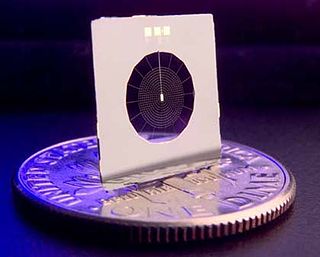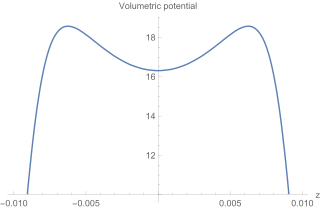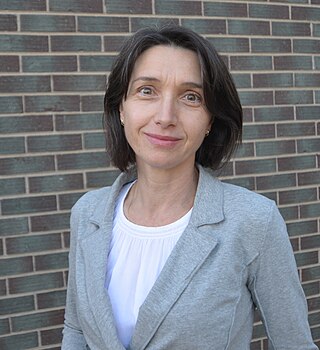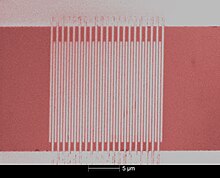Photoconductivity is an optical and electrical phenomenon in which a material becomes more electrically conductive due to the absorption of electromagnetic radiation such as visible light, ultraviolet light, infrared light, or gamma radiation.

A bolometer is a device for measuring radiant heat by means of a material having a temperature-dependent electrical resistance. It was invented in 1878 by the American astronomer Samuel Pierpont Langley.
A Bell test, also known as Bell inequality test or Bell experiment, is a real-world physics experiment designed to test the theory of quantum mechanics in relation to Albert Einstein's concept of local realism. Named for John Stewart Bell, the experiments test whether or not the real world satisfies local realism, which requires the presence of some additional local variables to explain the behavior of particles like photons and electrons. As of 2015, all Bell tests have found that the hypothesis of local hidden variables is inconsistent with the way that physical systems behave.

Photodetectors, also called photosensors, are sensors of light or other electromagnetic radiation. There are a wide variety of photodetectors which may be classified by mechanism of detection, such as photoelectric or photochemical effects, or by various performance metrics, such as spectral response. Semiconductor-based photodetectors typically use a p–n junction that converts photons into charge. The absorbed photons make electron–hole pairs in the depletion region. Photodiodes and photo transistors are a few examples of photo detectors. Solar cells convert some of the light energy absorbed into electrical energy.
Narrow-gap semiconductors are semiconducting materials with a magnitude of bandgap that is smaller than 0.5 eV, which corresponds to an infrared absorption cut-off wavelength over 2.5 micron. A more extended definition includes all semiconductors with bandgaps smaller than silicon. Modern terahertz, infrared, and thermographic technologies are all based on this class of semiconductors.
Indium gallium arsenide (InGaAs) is a ternary alloy of indium arsenide (InAs) and gallium arsenide (GaAs). Indium and gallium are group III elements of the periodic table while arsenic is a group V element. Alloys made of these chemical groups are referred to as "III-V" compounds. InGaAs has properties intermediate between those of GaAs and InAs. InGaAs is a room-temperature semiconductor with applications in electronics and photonics.
Quantum-cascade lasers (QCLs) are semiconductor lasers that emit in the mid- to far-infrared portion of the electromagnetic spectrum and were first demonstrated by Jérôme Faist, Federico Capasso, Deborah Sivco, Carlo Sirtori, Albert Hutchinson, and Alfred Cho at Bell Laboratories in 1994.
Cryogenic particle detectors operate at very low temperature, typically only a few degrees above absolute zero. These sensors interact with an energetic elementary particle and deliver a signal that can be related to the type of particle and the nature of the interaction. While many types of particle detectors might be operated with improved performance at cryogenic temperatures, this term generally refers to types that take advantage of special effects or properties occurring only at low temperature.

Niobium nitride is a compound of niobium and nitrogen (nitride) with the chemical formula NbN. At low temperatures NbN becomes a superconductor, and is used in detectors for infrared light.
Ghost imaging is a technique that produces an image of an object by combining information from two light detectors: a conventional, multi-pixel detector that does not view the object, and a single-pixel (bucket) detector that does view the object. Two techniques have been demonstrated. A quantum method uses a source of pairs of entangled photons, each pair shared between the two detectors, while a classical method uses a pair of correlated coherent beams without exploiting entanglement. Both approaches may be understood within the framework of a single theory.
The superconducting tunnel junction (STJ) — also known as a superconductor–insulator–superconductor tunnel junction (SIS) — is an electronic device consisting of two superconductors separated by a very thin layer of insulating material. Current passes through the junction via the process of quantum tunneling. The STJ is a type of Josephson junction, though not all the properties of the STJ are described by the Josephson effect.

A transition-edge sensor (TES) is a type of cryogenic energy sensor or cryogenic particle detector that exploits the strongly temperature-dependent resistance of the superconducting phase transition.
A single-photon source is a light source that emits light as single particles or photons. Single-photon sources are distinct from coherent light sources (lasers) and thermal light sources such as incandescent light bulbs. The Heisenberg uncertainty principle dictates that a state with an exact number of photons of a single frequency cannot be created. However, Fock states can be studied for a system where the electric field amplitude is distributed over a narrow bandwidth. In this context, a single-photon source gives rise to an effectively one-photon number state.

The kinetic inductance detector (KID) — also known as a microwave kinetic inductance detector (MKID) — is a type of superconducting photon detector first developed by scientists at the California Institute of Technology and the Jet Propulsion Laboratory in 2003. These devices operate at cryogenic temperatures, typically below 1 kelvin. They are being developed for high-sensitivity astronomical detection for frequencies ranging from the far-infrared to X-rays.

Photon counting is a technique in which individual photons are counted using a single-photon detector (SPD). A single-photon detector emits a pulse of signal for each detected photon. The counting efficiency is determined by the quantum efficiency and the system's electronic losses.
Richard Magee Osgood Jr. was an American applied and pure physicist. He was Higgins Professor of Electrical Engineering and Applied Physics at Columbia University.

A camelback potential is potential energy curve that looks like a normal distribution with a distinct dip where the peak would be, so named because it resembles the humps on a camel's back. The term was applied to a configuration of a superconducting quantum interference device in 2009, and to an arrangement of magnets in 2014.
A quantum dot single-photon source is based on a single quantum dot placed in an optical cavity. It is an on-demand single-photon source. A laser pulse can excite a pair of carriers known as an exciton in the quantum dot. The decay of a single exciton due to spontaneous emission leads to the emission of a single photon. Due to interactions between excitons, the emission when the quantum dot contains a single exciton is energetically distinct from that when the quantum dot contains more than one exciton. Therefore, a single exciton can be deterministically created by a laser pulse and the quantum dot becomes a nonclassical light source that emits photons one by one and thus shows photon antibunching. The emission of single photons can be proven by measuring the second order intensity correlation function. The spontaneous emission rate of the emitted photons can be enhanced by integrating the quantum dot in an optical cavity. Additionally, the cavity leads to emission in a well-defined optical mode increasing the efficiency of the photon source.

The DARPA Quantum Network (2002–2007) was the world's first quantum key distribution (QKD) network, operating 10 optical nodes across Boston and Cambridge, Massachusetts. It became fully operational on October 23, 2003 in BBN's laboratories, and in June 2004 was fielded through dark fiber under the streets of Cambridge and Boston, where it ran continuously for over 3 years. The project also created and fielded the world's first superconducting nanowire single-photon detector. It was sponsored by DARPA as part of the QuIST program, and built and operated by BBN Technologies in close collaboration with colleagues at Harvard University and the Boston University Photonics Center.

Adriana Eleni Lita is a Romanian materials scientist who is a member of the faint photonics group at National Institute of Standards and Technology. She works on fabrication and development of single-photon detectors such as transition-edge sensors and superconducting nanowire single-photon detector devices.










